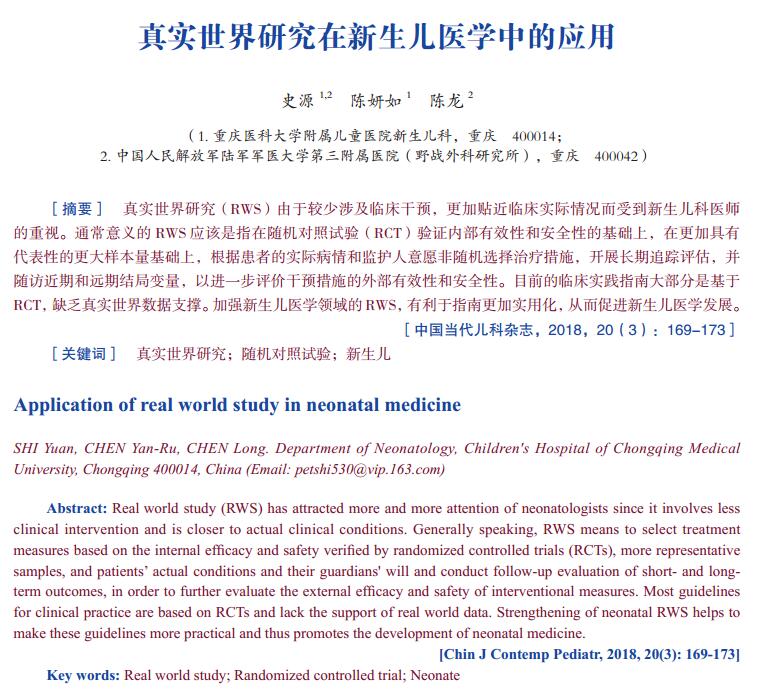 PDF(873 KB)
PDF(873 KB)


 PDF(873 KB)
PDF(873 KB)
 PDF(873 KB)
PDF(873 KB)
真实世界研究在新生儿医学中的应用
Application of real world study in neonatal medicine
真实世界研究(RWS)由于较少涉及临床干预,更加贴近临床实际情况而受到新生儿科医师的重视。通常意义的RWS应该是指在随机对照试验(RCT)验证内部有效性和安全性的基础上,在更加具有代表性的更大样本量基础上,根据患者的实际病情和监护人意愿非随机选择治疗措施,开展长期追踪评估,并随访近期和远期结局变量,以进一步评价干预措施的外部有效性和安全性。目前的临床实践指南大部分是基于RCT,缺乏真实世界数据支撑。加强新生儿医学领域的RWS,有利于指南更加实用化,从而促进新生儿医学发展。
Real world study (RWS) has attracted more and more attention of neonatologists since it involves less clinical intervention and is closer to actual clinical conditions. Generally speaking, RWS means to select treatment measures based on the internal efficacy and safety verified by randomized controlled trials (RCTs), more representative samples, and patients' actual conditions and their guardians' will and conduct follow-up evaluation of short-and long-term outcomes, in order to further evaluate the external efficacy and safety of interventional measures. Most guidelines for clinical practice are based on RCTs and lack the support of real world data. Strengthening of neonatal RWS helps to make these guidelines more practical and thus promotes the development of neonatal medicine.

[1] 叶鸿瑁. 常见症状和鉴别诊断[M]//邵肖梅, 叶鸿瑁, 邱小汕. 实用新生儿学. 第4版. 北京:人民卫生出版社, 2011:240-266.
[2] Henderson-Smart DJ, Steer PA. Caffeine versus theophylline for apnea in preterm infants[J]. Cochrane Database Syst Rev, 2010, (1):CD000273.
[3] Henderson-Smart DJ, Davis PG. Prophylactic methylxanthines for extubation in preterm infants[J]. Cochrane Database Syst Rev, 2003, (1):CD000139.
[4] Schmidt B, Roberts RS, Davis P, et al. Caffeine therapy for apnea of prematurity[J]. N Engl J Med, 2006, 354(20):2112-2121.
[5] Schmidt B, Roberts RS, Davis P, et al. Long-term effects of caffeine therapy for apnea of prematurity[J]. N Engl J Med, 2007, 357(19):1893-1902.
[6] Schmidt B, Anderson PJ, Doyle LW, et al. Survival without disability to age 5 years after neonatal caffeine therapy for apnea of prematurity[J]. JAMA, 2012, 307(3):275-282.
[7] Dukhovny D, Lorch SA, Schmidt B, et al. Economic evaluation of caffeine for apnea of prematurity[J]. Pediatrics, 2011, 127(1):e146-e155.
[8] Schoen K, Yu T, Stockmann C, et al. Use of methylxanthine therapies for the treatment and prevention of apnea of prematurity[J]. Paediatr Drugs, 2014, 16(2):169-177.
[9] Lista G, Fabbri L, Polackova R, et al. The real-world routine use of caffeine citrate in preterm infants:a European postauthorization safety study[J]. Neonatology, 2016, 109(3):221-227.
[10] Chaudhari SK, 陈厚炎, 谭举方, 等. 不同剂量枸橼酸咖啡因和氨茶碱治疗早产儿呼吸暂停的研究[J].中国新生儿科杂志, 2016, 31(5):348-352.
[11] Vázquez-Baeza Y, Callewaert C, Debelius J, et al. Impacts of the human gut microbiome on therapeutics[J]. Annu Rev Pharmacol Toxicol, 2018, 58:253-270.
[12] De Luca D, van Kaam AH, Tingay DG, et al. The Montreux definition of neonatal ARDS:biological and clinical background behind the description of a new entity[J]. Lancet Respir Med, 2017, 5(8):657-666.
[13] Pediatric Acute Lung Injury Consensus Conference Group. Pediatric acute respiratory distress syndrome:consensus recommendations from the Pediatric Acute Lung Injury Consensus Conference[J]. Pediatr Crit Care Med, 2015, 16(5):428-439.
[14] U.S. House Energy and Commerce Committee. Text of house amendment to the senate amendment to H.R.34, Tsunami Warning, Education and Research Act of 2015[DB/OL]. http://www.congress.gov/114/bills/hr34/BILLS-114hr34enr.pdf.
[15] Sherman RE, Anderson SA, Dal Pan GJ, et al. Real-world evidence-What is it and what can it tell us?[J]. N Engl J Med, 2016, 375(23):2293-2297.
[16] 基于婴儿期日龄分期的新生儿后期新概念多中心协作组:陈龙, 李婕, 王燕, 等. 基于婴儿期日龄分期的新生儿后期新概念[J]. 中国循证儿科杂志, 2017, 12(4):273-277.
[17] Stefanescu BM, Murphy WP, Hansell BJ, et al. A randomized, controlled trial comparing two different continuous positive airway pressure systems for the successful extubation of extremely low birth weight infants[J]. Pediatrics, 2003, 112(5):1031-1038.
[18] Bhandari V. Nasal intermittent positive pressure ventilation in the newborn:review of literature and evidence-based guidelines[J]. J Perinatol, 2010, 30(8):505-512.
[19] Tang S, Zhao J, Shen J, et al. Nasal intermittent positive pressure ventilation versus nasal continuous positive airway pressure in neonates:a systematic review and meta-analysis[J]. Indian Pediatr, 2013, 50(4):371-376.
[20] Meneses J, Bhandari V, Alves JG. Nasal intermittent positive-pressure ventilation vs nasal continuous positive airway pressure for preterm infants with respiratory distress syndrome:a systematic review and meta-analysis[J]. Arch Pediatr Adolesc Med, 2012, 166(4):372-376.
[21] Lemyre B, Laughon M, Bose C, et al. Early nasal intermittent positive pressure ventilation (NIPPV) versus early nasal continuous positive airway pressure (NCPAP) for preterm infants[J]. Cochrane Database Syst Rev, 2016, 12:CD005384.
[22] Meneses J, Bhandari V, Alves JG, et al. Noninvasive ventilation for respiratory distress syndrome:a randomized controlled trial[J]. Pediatrics, 2011, 127(2):300-307.
[23] Kirpalani H, Millar D, Lemyre B, et al. A trial comparing noninvasive ventilation strategies in preterm infants[J]. N Engl J Med, 2013, 369(7):611-620.
[24] Li W, Long C, Zhangxue H, et al. Nasal intermittent positive pressure ventilation versus nasal continuous positive airway pressure for preterm infants with respiratory distress syndrome:a meta-analysis and up-date[J]. Pediatr Pulmonol, 2015, 50(4):402-409.
[25] Chen L, Wang L, Li J, et al. Noninvasive ventilation for preterm twin neonates with respiratory distress syndrome:a randomized controlled trial[J]. Sci Rep, 2015, 5:14483.